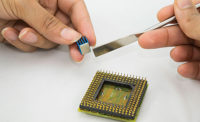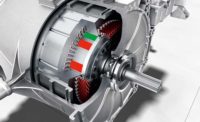Two-component epoxies are suitable for structural bonding and protective potting. For many industrial applications, the time lapse before reaching initial strength has been deemed a major disadvantage—until now. For the first time, there is a viable and instantaneous form of light fixation for two-component epoxies. This new technology promises to speed up and simplify the assembly process.
Over the past several years, dual-curing acrylic and silicone adhesives have greatly shortened adhesive bonding time in high-volume assembly applications. When exposed to high-intensity UV light, these adhesives can bond two parts within seconds before the resin achieves full strength via a secondary curing mechanism. This has enormously reduced wait times for further processing of an assembly. In addition, UV-curing adhesives have enabled more precise assembly. Parts can be carefully aligned and then bonded instantly, without the need for clamping or fixturing. This has been crucial for coping with the increasing level of miniaturization in many sectors.
Known for their strength, chemical resistance and reliable curing at room temperature, two-component epoxies were unable to keep pace with this trend because they lacked a light-fixation capability. However, there is now a dual-curing process suitable for two-component epoxies used in production environments. It combines the strengths of two-component products with the advantages of light fixation.
Simpler and Faster Production
This new hybrid chemistry is faster than any previous two-component epoxy. After just a few seconds of irradiation, the components are sufficiently secured in their joined positions and protected against slipping so that processing of the entire assembly can go ahead immediately. The strength after an irradiation time of only 5 seconds at an intensity of 1,000 milliwatts per square centimeter (mW/cm²) already amounts to 1 newton per square millimeter, a value that is often defined in the industry as initial strength.
Reliable final curing, including shadowed areas, is the same as it is for regular two-component epoxies at room temperature. Another option is to use heat to accelerate final curing. Typically, complete cross-linking takes place in 60 minutes at 80 C. Higher temperatures will shorten curing time, while lower ones will extend it.
A light-curing process at room temperature would be more attractive to assemblers because it saves them from investing in an oven, reduces energy costs, saves space on the production floor, reduces cycle times and increases throughput. Since dispensing, joining and light fixation take place in less than one minute, the next production step can begin much faster. Previously, assemblers would typically have to wait 15 to 90 minutes for the adhesive to reach green strength. The light-curing process also has a much lower carbon footprint than heat curing.
The only equipment needed to process light-curing two-component epoxies are a meter-mix dispensing system and a UV lamp. But, those costs are insignificant compared to the cost of a curing oven.
Two-component UV-cure epoxies are also easier to store and transport. Unlike one-component heat-curing epoxies, two-component UV-cure epoxies can be transported at room temperature and can commonly be stored for 12 months. Once the containers have been opened, they have a shelf-life of several weeks. As a result, assemblers can purchase the adhesive in larger and more economical containers.
Mechanical Properties
Light-fixable two-component epoxies provide very good mechanical properties, including good bond strength. This strength is achieved thanks to the strong cross-linking capacity of epoxies. The tensile shear strength of the first product available, DELO-Duopox DB8989, on aluminum is 28 megapascals (MPa) and compression shear strength on liquid crystal polymer, known to be difficult to bond, is 13 MPa.
The adhesives maintain their strength even when exposed to high heat and high humidity. For example, in aging simulations specified in the automotive sector, the adhesives maintained their strength despite being exposed to a temperature of 85 C and a relative humidity of 85 percent for 500 hours. They even maintained their strength despite being exposed to a temperature of 150 C for 500 hours. This high level of temperature resistance equates to a service temperature range of up to 180 C.
Another advantage of these new adhesives is that full curing takes place even in shadowed areas that are not irradiated. Testing has shown that the Young’s modulus of DELO-Duopox DB8989 is comparable in the areas exposed to light and areas shaded from light, even after challenging aging simulations. In other words, the mechanical properties of the cured adhesive are identical in both shaded and unshaded areas. As a result, engineers can be confident that the adhesive will remain viable even if subsequent design changes lead to different part geometries.
Application Prospects
This new hybrid chemistry is suitable for structural bonding and encapsulation. With a Young’s modulus ranging from less than100 MPa to 4,500 MPa, and elongation at tear ranging from 3 to 100 percent, the first products offer versatile application options. Examples are the bonding of rare-earth magnets in electric motors or the protective encapsulation of sensors.
Thanks to low outgassing and shrinkage, the product is also suitable for optoelectronic applications, such as the cameras used in automatic driving assistance systems. For the future, engineers can look forward to the development of many more two-component products with light fixation.








